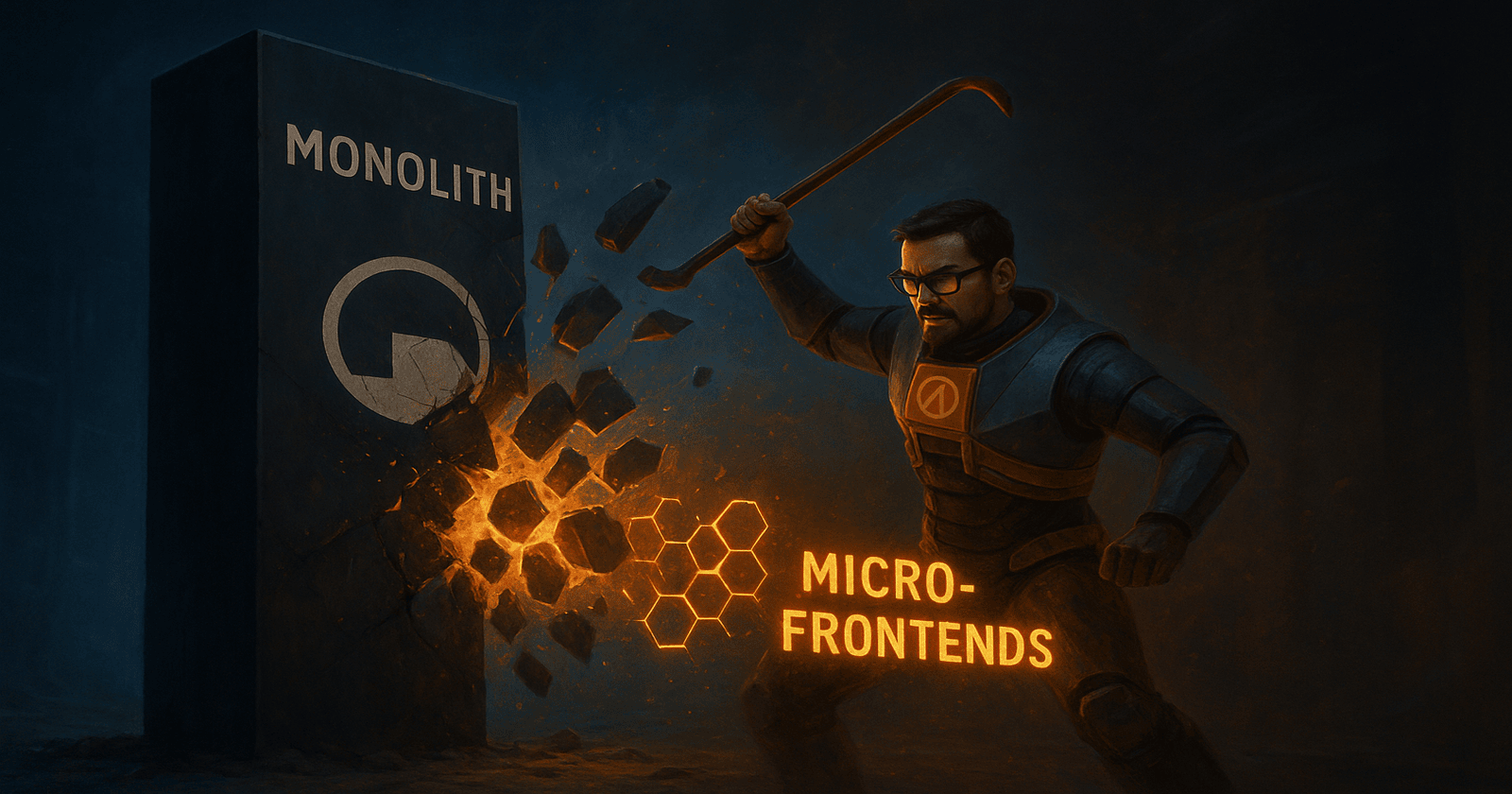"The right man in the wrong place can make all the difference in the world." - G-Man 🕴️
Welcome, fellow scientist! 👋 Or should I say, software engineer? Today, we're not in a top-secret research facility, but we are about to embark on a journey that will feel just as groundbreaking. We'll be trading our crowbars for keyboards and our HEV suits for IDEs as we explore the world of micro-frontends, all through the lens of the legendary Half-Life saga.
The Black Mesa Incident: A Monolithic Disaster 💥
Remember Black Mesa? A sprawling, interconnected facility where every department was part of one massive, monolithic structure. In the world of software, we call this a monolithic frontend. It's an application where all the UI components, business logic, and data access layers are bundled into a single, tightly-coupled codebase.
/black-mesa-facility
|-- /src
| |-- /components
| | |-- AnomalousMaterialsLab.js
| | |-- LambdaComplex.js
| | |-- SectorC_TestLabs.js
| |-- /services
| | |-- AntiMassSpectrometer.js
| | |-- TauCannon.js
| |-- App.js
|-- package.json
Just like Black Mesa, a monolithic frontend can seem efficient at first. Everyone is working on the same codebase, sharing components and resources. But what happens when something goes wrong? In Half-Life, a "resonance cascade" caused a catastrophic failure across the entire facility. In our world, a single bug in one part of the monolith can bring down the entire application.
The Perils of the Monolith 🧱
- 🐢 Slow Development: As the application grows, so does the complexity. Adding new features or fixing bugs becomes a slow and painful process.
- 💣 High-Risk Deployments: A small change requires a full redeployment of the entire application, increasing the risk of introducing new bugs.
- 🔒 Technology Lock-in: You're stuck with the technology choices you made at the beginning. Upgrading or adopting new technologies is a monumental task.
- 얽 Lack of Autonomy: Teams are not independent. They have to coordinate their work, leading to communication overhead and delays.
Gordon Freeman's Journey: The Rise of Micro-Frontends 🚀
Enter Gordon Freeman, our hero and a symbol of change. His journey through the shattered remains of Black Mesa, his fight against alien invaders, and his eventual journey to Xen is a perfect metaphor for the shift from monolithic frontends to micro-frontends.
Micro-frontends are an architectural style where a web application is decomposed into smaller, independent "micro-apps." Each micro-app is responsible for a specific feature or domain of the application.
/xen-micro-frontends
|-- /header-app
| |-- /src
| |-- package.json
|-- /product-list-app
| |-- /src
| |-- package.json
|-- /shopping-cart-app
| |-- /src
| |-- package.json
|-- /container-app
| |-- /src
| |-- package.json
Just as Gordon had to adapt and use different tools and strategies to overcome various challenges, micro-frontends allow teams to choose the right technology for the job. One team might use React for the product catalog, while another uses Vue for the shopping cart.
The Power of Micro-Frontends ✨
- 🧑🤝🧑 Independent Teams: Each team can work on their micro-app independently, leading to faster development cycles and increased productivity.
- 🎨 Technology Freedom: Teams can choose the best technology for their specific needs, allowing for innovation and experimentation.
- 💪 Resilience: A failure in one micro-app doesn't bring down the entire application. The rest of the application remains functional.
- ⚖️ Scalability: Each micro-app can be scaled independently, allowing for better resource utilization.
Building Your Own "HEV Suit": Implementing Micro-Frontends 🛠️
So, how do you build your own "HEV suit" and embrace the power of micro-frontends? There are several popular techniques:
- Module Federation: A feature of Webpack 5 that allows you to share code and dependencies between multiple applications.
- Iframes: A simple and effective way to embed one web page within another.
- Web Components: A set of web platform APIs that allow you to create custom, reusable, and encapsulated HTML tags.
Here's a simple example of how you might use Module Federation to create a micro-frontend architecture:
// container-app/webpack.config.js
const { ModuleFederationPlugin } = require('webpack').container;
module.exports = {
// ...
plugins: [
new ModuleFederationPlugin({
name: 'container',
remotes: {
header: 'header@http://localhost:3001/remoteEntry.js',
productList: 'productList@http://localhost:3002/remoteEntry.js',
},
}),
],
};
The G-Man's Wisdom: A Word of Caution ⚠️
"Prepare for unforeseen consequences." - G-Man
While micro-frontends offer many benefits, they also come with their own set of challenges. Increased complexity in managing multiple repositories, coordinating deployments, and ensuring a consistent user experience are all things to consider.
But just like Gordon Freeman, with the right tools, the right team, and the right mindset, you can overcome these challenges and build a better, more resilient web.
So, the next time you find yourself in a "resonance cascade" of monolithic proportions, remember the lessons from Half-Life. Embrace the chaos, break things down, and build something better.
And who knows, you might just save the world 🌍... or at least, your application. 💻
/`·.¸
/¸...¸`:·
¸.·´ ¸ `·.¸.·´)
: © ):´; ; ´)
`·.¸ `· ¸.·´\`·¸)
`\\´´\¸.·´
